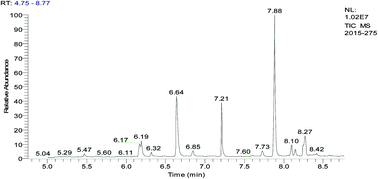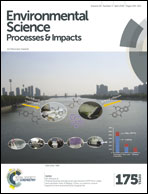Transformation of microcystins to 2-methyl-3-methoxy-4-phenylbutyric acid by room temperature ozone oxidation for rapid quantification of total microcystins†
Abstract
Microcystins (MCs) are cyanobacterial hepatotoxins capable of accumulation into animal tissues. To determine the total microcystins in water, a novel analytical method, including ozonolysis, methylation of 2-methyl-3-methoxy-4-phenylbutyric acid (MMPB) with methylchloroformate (MCF) and gas chromatography mass spectrometry (GC-MS) detection was developed. The results show that MCs can be oxidized by ozone to produce MMPB at ambient temperature, proving ozonation is an effective, rapid and green method for the transformation of MCs to MMPB without secondary pollution. The oxidation conditions as well as the esterification process were optimized and, subsequently applied to analysis of environmental samples. The method shows wide linear range and high sensitivity with a detection limit of 0.34 μg L−1. The established method was successfully applied to the analysis of microcystins in water samples.

- This article is part of the themed collection: Editor’s Choice: Underappreciated Science

 Please wait while we load your content...
Please wait while we load your content...